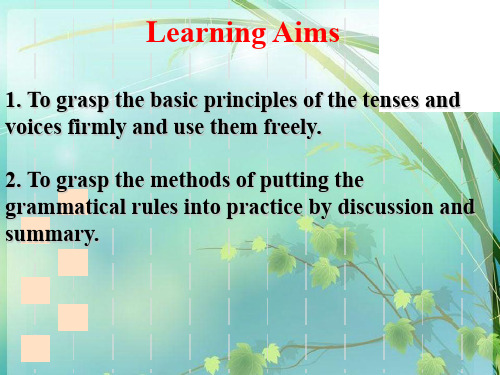高考英语动词时态语态复习(2)PPT课件
合集下载
高考时态语态的讲解课件(共30张PPT)

现在进行时 am /is / are + Ving am /is /are + being + Vp.p
过去进行时 was /were + Ving was /were + being、考查在语境中判断动词时态的运用能力。常 考的时态为:一般现在、一般过去、一般将来、 现在进行、过去进行、现在完成、过去完成、现 在完成进行、过去将来等。 2、时间、条件、让步等状语从句中动词的时态; 主从句时态呼应问题。
动词可分为:
行为动词
{及物动词 不及物动词 连系动词 情态动词 助动词
动词的分类
谓语动词
动词 非谓语动 词
时态、语态 虚拟语气
不定式 动名词
现在分词 分词
过去分词
语态 时态
主动
被动
一般现在时 v. /v.s
am /is /are + Vp.p
一般过去时 ved
was / were + Vp.p
up to now, in the past/last years, already, recently
一般过去
yesterday, last week, the other day, in 1949, at that time, once, a few days ago, when…(表过去)
at nine last night, the whole morning, all day, 过去进行 yesterday, from nine to ten last night… when,
3、几种时态的替代问题.
最常用的几种时态与时间状语的搭配
一般现在 Every day, from time to time, often, always…
【高三一轮复习语法】动词的时态与语态(共28张ppt)

②在条件状语从句和时间状语从句中用一般现在时表将来(主将从现)。 If you leave tomorrow , I'll see you at the airport. 如果你明天走,我到机场送你。 When she comes, I'll tell her about it. 她来时我将把这件事告诉她。 (2)现在进行时表将来 现在进行时表示将来,往往是指计划好或准备要做的事。一些表示动作 转换的动词,如go, come, leave, start, begin,stay,take off,arrive等,或 者也称为位移性动词,其进行时表示马上要做某事。
• He used to get up early . 过去他总是早起。(现在不这样了) • He will be used to getting up early . 他将会习惯早起。 • Wood is used to make paper. 木材被用来造纸。
(三)一般将来时
1、表示将要发生的动作或存在的状态,常用的时间状语有later(on), soon, in a month, next time, from now on, tomorrow等。 I shall be eighteen years old next year. 明年我就十八岁了。 2、一般将来时的其它表示形式 (1)一般现在时表将来 ①按照计划或时刻表要发生的事情。 The new library opens next month. 新图书馆下月开放。 The plane takes off at 3:00 P.m. 飞机于下午三点起飞。
We are about to discuss this problem.我们将马上讨论这个问题。 They were about to leave when the telephone rang. 他们正要离开时电 话响了。
【高考】语法动词的态与语态ppt课件

He looks upset. Do you know why? 他看起来很沮丧。你知道原因吗?
2. 表示客观存在及普遍真理。
综合演练
3. 表示现在经常和习惯性发生的动作,常与 sometimes, often, usually, always, every...等时间状语连用。 4. 一般现在时表将来的动作 (1)在由 when, after, before, as, as soon as, although, if, even if, in case, till, until, unless, as long as, where, whatever, wherever 等引导的时间、条件或让 步状语从句中常用一般现在时表将来。
I haven't eaten anything since breakfast. 我从早餐后到现在一直没有吃东西。
综合演练
3. 现在完成时用于固定句型中 (1)It/This/That is+the first/second/...time that+现在完成时. (2)This/That/It is the+形容词最高级+名词(+that)+现在完成时.
He has died for two years.(错误) He has been dead for two years.(正确)
综合演练
(2)现在完成时与一般过去时的区别 现在完成时强调过去的动作对现在的影响和结果;一般过去时只是对过去 动作的叙述,与现在没有关系。
He hasn't turned off the light yet. 他还没有关灯。(灯还亮着)
I have been calling him many times this morning, but there's no answer. 今天早晨我给他打了很多电话,但是没人接。
高考英语复习谓语动词时态语态课件

⑤情态动词:can, could, must, should +动词原形 .
时态体现在句子的谓语动词 语态:主动语态、被动语态 主动语态表示主语是动作的执行者。 They built a bridge over the river. 被动语态表示主语是动作的承受者。 A bridge was built over the river (by them).
number of areas that w__e_re_ (be) previously unprotected, bringing many of the existing protected areas for giant pandas under one authority to increase effectiveness and reduce inconsistencies in management.
3.(2022·新高考Ⅱ卷)Henry _w__as__fi_x_in_g___ (fix) his car when he heard the screams. 4.(2022·全国甲卷)In the last five years, Cao _h_a_s__w_a_lk_e_d__ (walk) through
12.in/over the last/past5 years在过去的5年时间里
表示在过去某一时刻或动作之前已经完成的动作,即 “过去的过去”;通常以一般过去时作参照。
past A B now
future
过去完成时 一般过去时 句中常含有:by/before+过去, by last year, by the end of 1998, by the time +过去
11.at the age of 5
时态体现在句子的谓语动词 语态:主动语态、被动语态 主动语态表示主语是动作的执行者。 They built a bridge over the river. 被动语态表示主语是动作的承受者。 A bridge was built over the river (by them).
number of areas that w__e_re_ (be) previously unprotected, bringing many of the existing protected areas for giant pandas under one authority to increase effectiveness and reduce inconsistencies in management.
3.(2022·新高考Ⅱ卷)Henry _w__as__fi_x_in_g___ (fix) his car when he heard the screams. 4.(2022·全国甲卷)In the last five years, Cao _h_a_s__w_a_lk_e_d__ (walk) through
12.in/over the last/past5 years在过去的5年时间里
表示在过去某一时刻或动作之前已经完成的动作,即 “过去的过去”;通常以一般过去时作参照。
past A B now
future
过去完成时 一般过去时 句中常含有:by/before+过去, by last year, by the end of 1998, by the time +过去
11.at the age of 5
高三英语复习:时态语态课件(共10张PPT)

将来进行时 will/shall be doing will/shall be being done
现在完成时
过去完成时 现在完成进行
时
have/has done had done
have/has been done had been done
have/has been doing
• 不同时态变被动的规律总结:
(2)结尾是s, x, sh, ch, o,前为辅音字母,结尾加es :
• watch— ___________ teach—___________
• go— ___________
do— __________
• wash— ___________
cross— ___________
• mix— __________
at a young age, during the trip, on my previous visits, on April 4, 2016, last night, at the last minute, 表示过 去一段时间内经常发生的或习惯性的动作 第44题 其他根据并列动词时态
固定句式: since 句式 第32,38,40,共3题。 被动语态: 第33,34,35,36,37,41,54,共7题。 不规则动词: 第30,32,33,44,54,共5题
• 保留原来时态中助(will/shall/would/am/is/ are/was/were/has/have/had),把be动词变 为原来时态中do的形式,再加动词的过去分词。
对动词时态语态考察形式的总结:
• 一般现在时:1-14题 • (1)表示现在的状态或经常、反复、习惯性的
动作。 第3题,共1题 (2)表示客观事实或普遍真理。 第1,2,5,6,14,共5题 (3)主将从现 第4,9,10,11,12,13,共5题
高中英语谓语动词时态和语态最全课件

• 还有几种特殊的形式也表示将来时态:
• 1.be going to+do表示:
• 主观上已经决定、打算、准备要做的事。 例如:I am going to buy a new car. 我打 算买辆新车。
• 某种迹象表明很可能发生的事情。例如: Dark clouds are gathering. It is going to rain.乌云密布,要下雨了。
there by air.
Exercise 2
用现在进行时翻译下列句子。 V.
1. 我星期五动身去北京。 leave / go2ຫໍສະໝຸດ 我的朋友今晚过来。come
3. 下周五我们乘飞机去上海。 fly
4. 下课后我们打算在操场踢足球。 play
1.我星期五动身去北京。 leave / go I’m leaving for Beijing this Friday. 2. 我的朋友今晚过来。 come My friends are coming over this evening. 3. 下周五我们乘飞机去上海。 fly We are flying to Shanghai next Friday. 4. 下课后我们打算在操场踢足球。 play After class we are playing football on the
• 2.be to+动词原型表示:
• 约定、计划或按职责、义务要求即将发生 的动作。例如:
• We are to meet at the train station at four this afternoon. 我们计划今天下午四点在 火车站见面
• The sports meet is to take place on Sunday morning.运动会将在周日上午举 行。
高三英语 时态和语态复习 (共53张PPT)

I stayed up last night, for I had a lot of homework to do. Where did you go just now?
2)表示在过去一段时间内,经常性或习惯性的动作。 When I was a child, I often played football in the street.
现在完成时
构成: have (has) +过去分词。
现在完成时常与一些时间状语连用, 如: already; yet; just; before; recently ; lately ;等。
1)表示动作发生在过去,但对现在有影响。如:
I have just come back from America.
The leaves are turning red. It's getting warmer and warmer.
c. 与always, constantly, forever 等词连用,表示反 复发生的动作或持续存在的状态,往往带有说话人 的主观色彩。
You are always changing your mind.
用于现在完成时的句型 1)It is the first / second time….the only--- that…结构中的
从句部分,用现在完成时。 It is the first time that I have visited the city. It is the only detective novel that I have ever read. 2)This is the… that…结构,that 从句要用现在完成时. This is the best film that I've (ever) seen. 这是我看过的最好的电影。
2)表示在过去一段时间内,经常性或习惯性的动作。 When I was a child, I often played football in the street.
现在完成时
构成: have (has) +过去分词。
现在完成时常与一些时间状语连用, 如: already; yet; just; before; recently ; lately ;等。
1)表示动作发生在过去,但对现在有影响。如:
I have just come back from America.
The leaves are turning red. It's getting warmer and warmer.
c. 与always, constantly, forever 等词连用,表示反 复发生的动作或持续存在的状态,往往带有说话人 的主观色彩。
You are always changing your mind.
用于现在完成时的句型 1)It is the first / second time….the only--- that…结构中的
从句部分,用现在完成时。 It is the first time that I have visited the city. It is the only detective novel that I have ever read. 2)This is the… that…结构,that 从句要用现在完成时. This is the best film that I've (ever) seen. 这是我看过的最好的电影。
动词的时态和语态-PPT课件

8. The man _h_a_d__h_o_p_e_d__ (hope) to catch the last train, but he was too late.
9. The boys __w_e_r_e_p_l_a_y_in_g___ (play) basketball from 5:00 to 6:00 yesterday.Βιβλιοθήκη .19练习
.
20
用所给动词的正确形式填空: 1. She _l_e_ft__ (leave) the office two
hours ago. 2. As son as she arrived home, the girl
discovered that she _h_a_d__t_a_k_e_n__ (take) her friends book by mistake. 3. Who _c_o_m__e_s__ (come) to school earliest in your class every morning? 4. Great changes _h_a_v_e_t_a_k_e_n_p__la_c_e__ (take place) in this city since 1979. 5. By the time he was twelve, Edison _h_a_d__b_e_g_u_n_ (begin.) to sell newspape21rs.
I’ll go to see you when I have time. I’ll go to see you if I have time tomorrow. 2. 某些动词,如:stand, continue, wish, love, like, hate, feel, find, think等常用一般现在时态
9. The boys __w_e_r_e_p_l_a_y_in_g___ (play) basketball from 5:00 to 6:00 yesterday.Βιβλιοθήκη .19练习
.
20
用所给动词的正确形式填空: 1. She _l_e_ft__ (leave) the office two
hours ago. 2. As son as she arrived home, the girl
discovered that she _h_a_d__t_a_k_e_n__ (take) her friends book by mistake. 3. Who _c_o_m__e_s__ (come) to school earliest in your class every morning? 4. Great changes _h_a_v_e_t_a_k_e_n_p__la_c_e__ (take place) in this city since 1979. 5. By the time he was twelve, Edison _h_a_d__b_e_g_u_n_ (begin.) to sell newspape21rs.
I’ll go to see you when I have time. I’ll go to see you if I have time tomorrow. 2. 某些动词,如:stand, continue, wish, love, like, hate, feel, find, think等常用一般现在时态
2022年高考英语二轮复习课件:专题一 谓语动词(动词的时态、语态、主谓一致、情态动词和虚拟语气)

用在时间、条件或让步状 When I grow up, I will be a nurse and look
语从句中, 用一般现在时表 after patients.
将来
我长大后要当一名护士, 照顾病人。
重点一
重点二
重点三
重点四
考点2 一般过去时(was/were或did)
用法
例句
表示过去某一时间发生的动作、 所处的状态或过去一段时间内 习惯性的动作或状态
代词
单个的动词-ing形式、动词不定式或主语从句
重点一
重点二
重点三
重点四
原则
主语
谓语
由and连接的两个并列成分表示两个不同的概念
有生命的集体名词, 如people, police, cattle等 一些常用作复数或只有复数形式的名词, 如goods,
stairs,
arms等
复数
山脉、群岛、瀑布等以-s结尾的专有名词
始了。
表示一个动作或状态从过 By the time Jack returned home from
去某一时间之前已经开始, 一直持续到过去这一时刻 的动作
England, his son had graduated from
college. 杰克从英国回到家中时, 他的儿子已 经大学毕业。
重点一
重点二
重点四
用法
例句
按时间表、日程表等安排
将要发生的动作, 只限于go, The flight takes off at 8:30 every Wednesday
arrive, leave, start, return, and Friday. begin, come, take off 等动词 这个航班每周三和周五八点半起飞。 (短语)
高考英语动词时态语态复习课件

be going to 有很强的计划性;打算干什么;而will表示谈 话时临时决定的意图;具有临时性和偶然性
① The telephone is ringing I _____ answer it
√A. will B am going to C am to D am about to
② Alice; why didn’t you come yesterday
3 用一般过去时表示过去经常发生的动作 也可用 used to do或 would do 代替 During the vacation I often swam /
would swim / used to swim in the sea 假期期间我常在大海里游泳
I used ur daily life as a high school student
using 3 sentences or more;使用实意动词 和系动词; 注意动词形式变化
一 一般现在时 The Simple Present tense
1 结构: do/does
2 用法: 1 经常性或习惯性的动作;常与表示频率 的时间状语连用;如often; usually; always; every day/year; sometimes; on Sunday等
My family have lived in Zhuhai for 10 years 目前还在珠海
2 过去时常与具体的表示过去的时间状语连用;而 现在完成时通常与不确定的或包括现在在内的时 间状语连用;或无时间状语
I study hard every day and I get along well with my classmates; but sometimes I miss my families
高考英语时态复习 PPT课件 图文

--- I had just finished my work and____ to take a shower.
A. had started B. started C. have started D. was starting
过去进行时表示过去将来.
1. 一般过去时和过去进行时 1. He ______ a book about China last year, but I
had meant/planned/intended to do…,表示过 去未曾实现的愿望、打算、想法等。
热点4:过去进行时
1. The last time I saw Jane she _w_a_s_p_i_c_k_in_g_ cotton in the fields. (pick)
2. ---Has Sam finished his homework today?
2. As she ___ the newspaper, Granny ___ asleep.
A. read; was falling
B. was reading; fell
C. was reading; was falling D. read; fell
结论:长动作在进行时,被一个短动作打断,长动 作用进行体,短动作用一般体.
造成影响和结果.
1.---The window is dirty. ---I know. It _ห้องสมุดไป่ตู้__ for weeks.
A. hasn’t cleaned B. didn’t clear C. wasn’t cleaned D. hasn’t been cleaned
2. --- Would you like to go to the cinema with me tomorrow afternoon?
A. had started B. started C. have started D. was starting
过去进行时表示过去将来.
1. 一般过去时和过去进行时 1. He ______ a book about China last year, but I
had meant/planned/intended to do…,表示过 去未曾实现的愿望、打算、想法等。
热点4:过去进行时
1. The last time I saw Jane she _w_a_s_p_i_c_k_in_g_ cotton in the fields. (pick)
2. ---Has Sam finished his homework today?
2. As she ___ the newspaper, Granny ___ asleep.
A. read; was falling
B. was reading; fell
C. was reading; was falling D. read; fell
结论:长动作在进行时,被一个短动作打断,长动 作用进行体,短动作用一般体.
造成影响和结果.
1.---The window is dirty. ---I know. It _ห้องสมุดไป่ตู้__ for weeks.
A. hasn’t cleaned B. didn’t clear C. wasn’t cleaned D. hasn’t been cleaned
2. --- Would you like to go to the cinema with me tomorrow afternoon?
高考英语动词时态语态考点[课件]
![高考英语动词时态语态考点[课件]](https://img.taocdn.com/s3/m/8d572d2c192e45361066f57a.png)
(5)用于在if, unless , even if 引导的条件状语从句中,由When , before , until , as soon as , the moment , once 引导的时间状语从句中,由no matter what/who/which/when /where/how 或 whatever ,whoever, whichever,whenever, wherever, however 引导的让步状语从句中, 这是主句往往用将来时, 或者是祈使句。 I will go as soon as I finish my work . If city noises are not kept from increasing , people will have to shout to be heard even at the dinner table 20 years from now . If you arrive tomorrow , call me . (6)表示按计划,时间表,时刻表规定要发生的动作,限于以下词:begin come , leave , go , arrive , start , stop, return , open , close 等。 The flight takes off at 2:30 every Wednesday and Friday . 2. 现在进行时(am/is/ are + doing ) (1)表示说话时正在进行的动作。 He is doing his homework, while His brother is sleeping now . (2)表示现阶段但不一定是发生在讲话时的一个动作。 Teenagers are damaging their health because they play computer games too much .
- 1、下载文档前请自行甄别文档内容的完整性,平台不提供额外的编辑、内容补充、找答案等附加服务。
- 2、"仅部分预览"的文档,不可在线预览部分如存在完整性等问题,可反馈申请退款(可完整预览的文档不适用该条件!)。
- 3、如文档侵犯您的权益,请联系客服反馈,我们会尽快为您处理(人工客服工作时间:9:00-18:30)。
4.现在进行时可以表示现在不断发展变化的事 情。
It’s late Autumn. The weather is getting colder and colder.
Correct the sentence.
All the students here is belonging to No.1 Middle School. __b_e_lo_n_g__
When does the bus start? It starts in 2 minutes.
现在进行时(The Present Continuous Tense)
1) 表示现在这个时刻( 指说话时)正在发生的事 情。 We _a_r_e__h_a_v_in_g__ (have) English class now.
【注意】 一般情况下,下面4类动词无进行时态:
(1)表心理状态、情感的动词:like, love, hate, care, remember, believe, want, mind, wish, agree, mean, need。
(2) 表存在的状态动词:have, appear, exist, lie, remain, seem, belong to, depend on。
他在学校表现很好。(一般事实)
现在完成时(The present Perfect Tense)
English Basic Tenses () & Voices(语态)
时态和语态的主要考点
1、考查在语境中判断动词时态的运用能力。常考的 时态为:一般现在时、现在进行时、现在完成时、 现在完成进行时、一般将来时、一般过去时、 过去进行时、过去完成时、 过去将来时等。 2、时间、条件、让步等状语从句中动词的时态; 主从句时态呼应问题。
The geography teacher told us that the earth moved around the sun. _m__o_v_e_s_
2)表客观事实、普遍真理。 注意:主语为第三人称单数(he/she/it或单个
的人名、单个的事物名称)谓语动词+s/es, 其余人称作主语谓语动词用原形.
. 一般现在时 ( The Present Indefinite ) 1)表经常性、习惯性的动作或状态,常与表示
频率的时间状语连用,如always, often/
usually/frequently, sometimes, every…, at …,on
Sundays/….
Correct the sentence.
(3) 瞬间动词:begin/start, allow, accept, permit, promise, admit, complete。
(4)感官动词:see, hear, notice, feel, smell, sound, taste, look。
Tips:
现在进行时的标志: Now, right now, at this moment, look,
这个女孩老是在公共场所高谈阔论。
★进行时态与always, often/usually/ frequently/ constantly/all the time等频度副词 连用,表经常反复的行动或说话人赞叹或厌恶等 感情色彩 .
3) 现在进行时用来表示按计划即将发生的 动作,多用于位移/终止性动词,如: come, go, arrive, leave, stay, fly, take off. I__a_m__l_e_a_v_in_g__ (leave) tomorrow. _A_r_e__ you __st_a_y_i_n_g (stay) here till next week?
The shop will close at 9:00 p.m. _c_lo_s_e_s
3) 表示按计划、规定,时间表将要发生的动作 或存在的状态, 一般用于be, come, go, start, begin, leave, arrive, return等位移/终止性动词, 常与时间状语连用.
The train leaves at 6 tomorrow morning.
listen…
现在进行时和一般现在时的比较
①暂时性动作和经常性动作
The computer is working perfectly. 计算机运转得很好。(暂时)
The computer works perfectly. 计算机运转很好。(一直如此)
②持续性动作和短暂性动作
The bus is stopping. 车停了下来。(渐渐地) The bus stops. 车停了。(迅速)
③暂时性动作和永久性动作 She is living in the country.
她现在住在农村。(暂时) She lives in the country.
她住ቤተ መጻሕፍቲ ባይዱ农村。(永久)
④有感情色彩和没有感情色彩 He is doing well at school.
他在学校表现很好。(赞扬) He does well at school.
3、延续性动词和终止性动词的用法区别。 4、及物动词(vt.)的被动语态。 5、某些以主动形式表被动意义的动词的用法。
动词的时态 ( Tenses)
Fill in the blanks. I _s_t_u_d_y (study) hard abroad every day and I __g_e_t_ (get) along well with my roommates, but sometimes I _m__is_s_ (miss) my families.
2) 表示目前这段时间内正在进行的动作, 但说话时动作未必正在进行。 She __is__le_a_r_n_i_n_g_ (learn) piano under Mr. Smith at present.
Translate the sentence.
The girl is always talking loud in public.
